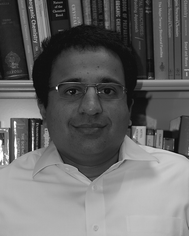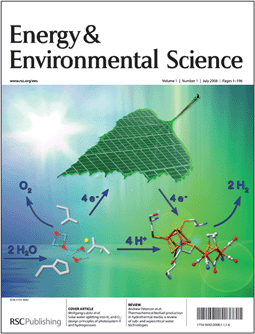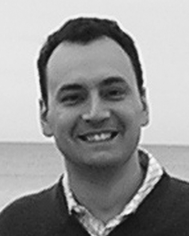New year, new innovations, more great science
Editorial Boards
From 1st January 2009 we welcome to Journal of Materials Chemistry two new Associate Editors for North America, Professor Vincent Rotello (Department of Chemistry, University of Massachusetts at Amherst; Fig. 1) and Professor Ram Seshadri (Materials Department, University of California, Santa Barbara; Fig. 2). Professor Fred Wudl is handing over his North American Editorial Office to both of them. It is a testament to Fred's great dedication and hard work over the past three years that this office must be replaced with two complementary offices which together cover the whole of North America from East Coast to West Coast and all materials, both organic and inorganic. Vince and Ram welcome papers from authors in the USA or Canada, and will also be active in representing the journal at meetings and commissioning high quality papers for publication in future issues of Journal of Materials Chemistry. | ||
| Fig. 1 Professor Vincent Rotello. | ||
 | ||
| Fig. 2 Professor Ram Seshadri. | ||
We also welcome two new Editorial Board Members, Dermot O'Hare (University of Oxford) and Stuart Rowan (Case Western Reserve University), and several new Advisory Board Members: Takashi Kato, M. Saiful Islam, Paul Mulvaney, Linda Nazar, Molly Stevens, Jan van Hest, Swapan Pati, Markus Niederberger, Sang Youl Kim, Paolo Samori, Carsten Tschierske, and John Irvine.
Read the profile in this issue for further information about the newcomers to the Editorial Board.
Many thanks go to the outgoing Board Members Carsten Tschierske and John Irvine, to the retiring Associate Editor Fred Wudl, and to all the retiring Advisory Board members: Tim Swager, Klaus Müllen, Tom Davis, John Goodby, Geff Ozin, S. W. Rhee, and Serdar Sariçiftçi. I hope that you will join us in welcoming all new Editorial and Advisory Board Members to the journal.
More papers and greater impact
As we look forward to 2009, RSC Publishing is working with more authors than ever before—2008 saw the number of authors published in RSC journals increase by 30%. Meanwhile titles from across the collection recorded impressive rises in impact factors, and the latest immediacy indices confirm the relevance and topicality of research published by the RSC.More specifically, the Journal of Materials Chemistry impact factor rose for the fourth year in a row, to a new highest-ever value of 4.34, proving that Journal of Materials Chemistry is going from strength to strength. This is a 59% growth over the last three years. Take a look at some of our most highly cited papers from 2007, listed in Table 1. We would like to thank the authors of all these papers for choosing Journal of Materials Chemistry.
| Biomimetic mineralization, An-Wu Xu, Yurong Ma and Helmut Cölfen, J. Mater. Chem., 2007, 17, 415 |
| Synthesis and application of highly ordered arrays of TiO2 nanotubes, Craig A. Grimes, J. Mater. Chem., 2007, 17, 1451 |
| Hydrogen storage in metal–organic frameworks, David J. Collins and Hong-Cai Zhou, J. Mater. Chem., 2007, 17, 3154 |
| Electrochromics for smart windows: thin films of tungsten oxide and nickel oxide, and devices based on these, Gunnar A. Niklasson and Claes G. Granqvist, J. Mater. Chem., 2007, 17, 127 |
| Nanowire and nanobelt arrays of zinc oxide from synthesis to properties and to novel devices, Xudong Wang, Jinhui Song and Zhong Lin Wang, J. Mater. Chem., 2007, 17, 711 |
| Photophysical, crystallographic, and electrochemical characterization of novel conjugated thiopheno azomethines, Marie Bourgeaux, Sergio Andrés Pérez Guarìn and W. G. Skene, J. Mater. Chem., 2007, 17, 972 |
| Electroluminescent devices from ionic transition metal complexes, Jason D. Slinker, Jonathan Rivnay, Joshua S. Moskowitz, Jeffrey B. Parker, Stefan Bernhard, Héctor D. Abruña and George G. Malliaras, J. Mater. Chem., 2007, 17, 2976 |
| Review of progress in shape-memory polymers, C. Liu, H. Qin and P. T. Mather, J. Mater. Chem., 2007, 17, 1543 |
| Electrophoretic deposition of donor–acceptor nanostructures on electrodes for molecular photovoltaics, Hiroshi Imahori, J. Mater. Chem., 2007, 17, 31 |
By comparison to 2007, in 2008 Journal of Materials Chemistry received 11% more submissions, and accepted 44% more papers. This is a measure of how quickly the journal is growing, and how the quality just keeps on increasing. We hope that you will continue to send us your top work in the coming year.
RSC Publishing is committed to providing a world-class publishing service and global visibility to its authors and with the number of citations increasing and impact factors rising it is clear to see that Journal of Materials Chemistry and RSC Publishing are recognised by researchers throughout the world as a key resource to publish and read the very best research.
Journal of Materials Chemistry Editorial Board award for best paper
In order to further promote the best work that is published in Journal of Materials Chemistry, we are introducing a new award to recognise the best publication in the journal each year from an early-stage researcher. The 2008 awardee must be the author of a paper published in Journal of Materials Chemistry within 2008, and the winner of the first award will be announced in early 2009—watch this space! The awardee must be within the first ten years of their career (first ten years since their PhD) and be the corresponding author on the paper. They will receive a cash lecture award as well as extra promotion through the journal. In order to be considered for this award, you must be an author of a Journal of Materials Chemistry paper from the last year—the final decision will be made by the Editorial Board when they meet each spring. So why not submit your best paper now to be in with a chance of winning the 2009 prize?Same great ReSourCe—just better!
During 2009 we will release a new version of ReSourCe, our system for online manuscript submission and peer review (www.rsc.org/resource). Already popular with authors and referees, we've listened to your feedback and made further improvements to our service. We're keen to build on your experience of ReSourCe, so if you would you like to help us shape the next release by taking part in beta-testing or by supplying your comments and suggestions please contact resourcesupport@rsc.org.Back cover adverts
We are now able to offer an exciting chance to feature the work of authors as a back cover advert in the issue in which the article appears. This is a premium space much sought after by advertisers. Some examples of recent back cover adverts we have produced are shown in Fig. 3. | ||
| Fig. 3 Some recent back cover adverts. | ||
This new alternative product gives authors something different that we've never offered before. As well as displaying a picture depicting their research, the design features the name of the lab and a short description of the work taking place. The back cover advert is promoted in a variety of ways and the authors also receive electronic copies and posters of the back cover advert.
So if you would like to be considered to have your work featured in this way, simply let the Editorial Office know when you submit your work or when it is accepted for publication.
Food: the RSC theme for 2009
In 2009, the theme for RSC public engagement activities will be food; looking at all aspects of the supply chain from field to fork and eventually to waste disposal and recycling. Planned activities include the launch of a major report into securing a sustainable food supply; the publication of a new edition of the ground-breaking book Kitchen Chemistry; lectures and events at the new Chemistry Centre at Burlington House—the world's foremost venue for showcasing chemistry; and Chemistry Week 2009 (7th–15th November), when practising scientists and science teachers will engage in a week-long festival for the chemical sciences. Please get in touch with us (food@rsc.org) if you would like to be involved.New journal announcement: Energy & Environmental Science
The new RSC journal Energy & Environmental Science, launched summer 2008, has had a tremendously successful start, publishing the most topical research for all aspects of the chemical sciences relating to energy conversion and storage, alternative fuel technologies, and environmental science. Visit the website and read the latest issue of Energy & Environmental Science and register to access all issues for free throughout 2009 at www.rsc.org/ees. | ||
| Fig. 4 Energy & Environmental Science. | ||
eBooks
The RSC eBook Collection has become a world-class electronic resource with licences being signed to leading institutions across the globe. New content continues to be uploaded regularly and this comprehensive resource now includes over 800 quality titles. Electronic book publications are uploaded within days of print publication, effortlessly disseminating extensive, high-quality, scientific content direct to scientists, libraries, students, teachers and researchers around the world. Please visit www.rsc.org/eBooks for further information or to visit the RSC eBook Collection.Over 80 new print books will be published in 2009 as our list continues to grow in size and importance in the international market. Keep up-to-date with all the latest cutting edge titles being published by the RSC by visiting www.rsc.org/ej_alert and subscribing to our eAlerts. We send regular information on discount offers, print books and new electronic content throughout the year.
Your RSC subscriptions and free content
We know that it can be difficult to keep track of online resources that are available to you. So, we've introduced a special web page to help you to find out exactly what RSC content you can access. This new page is called Your RSC Subscriptions (www.rsc.org/Publishing/your_access.asp) and it lists all products for which your organisation has a current subscription, plus other content which may be available to you, such as the RSC Journals Archive and the RSC eBook collection.You can also find out about RSC content that is available free—including: research articles that are free for a limited time; news articles in magazines; and free chapters from the RSC eBook Collection. Visit www.rsc.org/Publishing/freeRSCcontent.asp
Editorial office
In addition to our two North American Associate Editor offices, our main Editorial office is located in Cambridge, UK, and all papers are handled by our qualified and professional staff (see Fig. 5) to ensure all authors receive fair, constructive and rigorous processing for their work, both pre- and post-acceptance. All Editors are happy to answer your queries and can also be seen out and about at conferences (check our website www.rsc.org/materials for details of when and where this might be), and we would like to further get to know you: our authors, our referees, and our readers. | ||
| Fig. 5 Materials Editorial and Informatics teams: (left to right): Back: Sylvia Pegg, Michelle Canning, Vikki Chapman, Alexandra Haywood, Nina Notman, Fay Riordan. Front: David Barden, Sophia Anderton, Carol Stanier, Christina Ableman. Not shown: Carole Martin, Paul Cooper. | ||
Wishing you all the best for 2009!
 | ||
| Plate1 Professor George Malliaras (Chair of the Editorial Board) | ||
 | ||
| Plate2 Dr Carol Stanier (Editor) | ||
| This journal is © The Royal Society of Chemistry 2009 |

